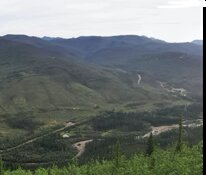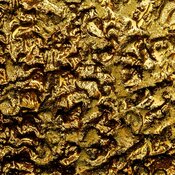Trey Wasser: I love Mexico. I grew up in San Diego and have traveled there my whole life. I have watched the country grow up and now see some distinct parallels to the U.S. in the '50s and '60s, although Mexico—like many of the emerging markets—is evolving much faster due to globalization and technology. Mexico is now so tied to the U.S. and Canada through NAFTA that I believe most of the political and business risk has been removed. The country has a very bright future.
TGR: And you've managed to tie all of that in with your interest in gold and silver.
TW: The mining history in Mexico intrigues me. No one really knows how long ago the Incas and Aztecs first started mining gold and silver, but the Spaniards really cranked things up in the early 1600s. Every state in Mexico is mineralized and has some type of mining history. Yet Mexico has seen very little modern exploration due to property laws that did not change until mid '80s. I expect that mining will be a major growth industry in Mexico for many years to come.
TGR: How did Pilot Point Partners and Due Diligence Tours evolve?
TW: Pilot Point Partners really evolved from a venture capital company I started in 1993 when I retired from the brokerage business, called III-D Capital. I consulted with several early-stage technology startups, helping them raise their first venture capital investment. By 1999, when the technology and internet business plans that I was seeing (and that were getting funded) had gotten way too speculative, I began to focus on natural resources, specifically mining and energy. I learned that there was very little independent research available in the junior mining sector and few U.S. investment banks involved in the space. I saw an opportunity to apply my research and consulting experience to junior mining companies operating in Mexico.
TGR: Where does Due Diligence Tours fit in that picture?
TW: Mark Twain once defined a gold mine as "a hole in the ground with a liar standing by it." All the companies look good at the trade shows and on their websites. I thought that there couldn't possibly be that many really good projects. It reminded me of the tech market of the late 1990s. I decided I needed to start visiting the properties.
Of course, many mining properties are very remote and it often means long rides on bad roads to reach them. Add the travel time to and from Mexico and you could spend four days to see a single project. Goldcorp (TSX:G) (NYSE:GG) had a great way to go about it. They'd arrange a tour of three or four of their Mexican mines and charter private aircraft to make the trip efficient, send out invitations and fill up the planes with analysts. I saw an opportunity to adapt that model and visit several different companies' properties on a single trip. Hence, Due Diligence Tours.
I've developed a model that helps identify the better projects and tracks the progress of their development. The people who travel with me know I have vetted the projects and companies on the tours and that I can generate an initial analysis from the model for them prior to the trip. This format is why several analysts have traveled with me multiple times since our first trip in 2007.
Generally speaking, companies sponsor these trips to their sites to generate analyst coverage and investment interest in private placements, so I don't typically travel with individual investors. However, I have had several inquiries and it looks like we may try to organize something later this year for individual investors.
TGR: Keep our readers posted on that.
TW: Of course.
TGR: Could you describe your model for following the companies?
TW: It's a proprietary model that I developed to evaluate companies, their properties and the development of the projects. It is called Mexican Silver and Gold Explorers—MSG. It compares the companies and the deposits on several different quantitative and qualitative dimensions on a matrix. The model tracks exploration companies from the grassroots stages as they develop their assets and move into production.
TGR: How long have you been using this model and what does its track record look like?
TW: Since its launch in January 2007 it is up over 250%. Unlike many gold stocks and indexes, the MSG did not drop below its initial value in 2008. Of the 20 companies included in my model earlier this year, five companies have been bought out or have done a significant strategic transaction with a larger company and a sixth turned down a low-ball offer. Three other companies have fully funded their projects and are moving into production.
TGR: Let's break those down into groups. Which three companies are moving into production?
TW: Timmins Gold Corp. (TSX.V:TMM), SilverCrest Mines Inc. (TSX.V:SVL) and Gold Resource Corp. (OTCBB:GORO, FSE:GIH)—which also formed a strategic alliance with Hochschild Mining (HOC: LSE) just over a year ago—have all fully funded their projects and are moving into production.
TGR: Which one turned down an offer?
TW: MAG Silver Corp. (TSX:MAG) (NYSE:MVG). Fresnillo plc (LSE:FRES) made a low-ball offer at the worst of the 2008 market correction. MAG management termed it a "take-under" and shareholders turned it down.
TGR: And finally, which five have been bought out or completed a significant strategic transaction?
TW: West Timmins Mining Inc. (TSX:WTM), Canplats Resources Corp. (TSX.V:CPQ), Orko Silver Corp. (TSX.V:OK), Gold Resource Corp. and Castle Gold Corporation (TSX.V:CSG).
TGR: Had you added these five companies to your model because you anticipated such transactions?
TW: No, they just measured up very well in the model. They were successfully growing their resource without significant dilution and were doing everything on the ground to move their projects toward production.
TGR: That suggests some of metrics you use to evaluate companies. What other criteria do you use to place a company into your MSG Model?
TW: Anticipated stock performance is the overriding criteria, because once a company is included in my model, it also becomes part of the MSG Index. In most cases, a stock being included (or dropped) from the model will be the result of a site visit. On the ground, I can usually get a pretty good feel for the project, the team in Mexico and their plans for development. The main thing I'm looking at with management is experience and the way they spend money. I look at how much money goes into the ground versus how much is used for promotion and corporate G&A. While that won't necessarily exclude somebody, it's a pretty good initial criteria. It generally will reflect on management's ability to move a project forward without blowing out the capital structure of the company. The capital structure is very important in determining what the company has accomplished with equity they've already raised and their ability to raise additional capital. So I track the stock dilution for the past five years versus in the advancement of the project and growth of the stated resource
TGR: Can you elaborate on what criteria you use to confirm that a project is developable?
TW: Some properties are just very remote or have other issues that will impede the economic viability of the known resource. They might look good on paper as the company reports good drill results and puts together a huge resource. In Mexico, surface rights and mineral rights are separate. Having mineral rights does not guarantee access and use of the land for mining. Most of the surface rights were granted to local communities called "Ejidos" by the federal government after the Mexican revolution. Securing these surface rights and access is very important and has been an issue at several mine developments. Water rights are also a big issue in many parts of Mexico, especially in Sonora and Baja where no new water rights are being granted. Permitting, in general, is not a problem in Mexico, but it can be an issue with certain projects if they are too close to an urban area,, a water source or an archeological site.
Underground mining in Mexico can also be challenging. The veins are generally very narrow. They are notorious for pinching and swelling in both width and grade. Feeding a mill from a long narrow underground vein can be difficult and get very expensive. Building and operating a mill also adds significantly to the cap-ex of a project. Raising the capital to develop an underground deposit may be difficult for a junior company. I generally prefer to see juniors working on open pit projects that can be heap leached and developed at a lower cost, without significant dilution. I am not a geologist or a mining engineer, but I travel with a pretty elite bunch through Due Diligence Tours. We have some pretty frank discussions about the projects. The main issue is always whether the project is developable. Ownership is also an important issue. I try to evaluate whether the company is capable of financing and developing the project on their own or if they'll need someone else to step in and develop the project through a sale or joint venture. Ownership of the project is very important. I like to see 100% ownership.
TGR: Why is that?
TW: If a company is already joint venturing the project to earn only 60% or 70%, it will be very difficult for them to find another partner or a buyer. Financing will be more difficult as well. If the joint venture is with a major company, there are often "claw-back" rights where the junior can be bought out of the project. This can mean that as a shareholder I am taking all the development risk and may not ever see the rewards of a fully developed project.
TGR: Does your model evaluate the ore bodies or do you rely on 43-101 reports?
TW: I read dozens of 43-101s and I encourage any investor to make these reports part of their due diligence on a junior mining company. They are important, but they aren't enough to fully evaluate a deposit. As you may know, the 43-101 is a mineral resource classification scheme supervised by the Canadian Securities Administrators and developed to regulate how public companies disclose scientific and technical information about mineral projects. This came about in response to a scandal in the late 1990s. The idea was to make each report a fully independent evaluation, but in reality the companies still have a lot of input into the reports.
The problem is that there aren't standardized calculations for modeling deposits, establishing cut-off grades and stating gold or silver equivalents from other metals. Much of the silver in Mexico is in poly-metallic ore, meaning it is mixed with lead and zinc. The companies like to convert the lead and zinc to "silver equivalent" ounces to state a bigger global resource. Converting lead and zinc to so-called "silver equivalent" ounces can be very deceiving. At current prices, 1% lead and 1% zinc would add about 3.5 ounces per ton to a silver resource in a "silver equivalent" calculation. But after typical recoveries, smelter charges and penalties, 1% lead and zinc aren't really economical. So a typical "silver equivalent" resource in Mexico might overstate the recoverable silver by a very significant amount.
Companies also like to play with the gold/silver ratios and state "gold equivalent" or "silver equivalent" ounces. This can make it very difficult to understand the ore body and model cash flows. Recoveries of the two metals may vary significantly and may not be considered in the resource estimate. This makes it very hard to compare one company to another because everyone uses different math. I do a lot of work to break down all the rock values to come up with my own economic and developable resource numbers. The companies don't always like it, but when their feasibility studies are published, my numbers are usually pretty close.
TGR: In addition to your model and index, you also have a watch list. Are the companies on your watch list part of the MSG Index or are you looking to see whether they'll make it into the Universe?
TW: I use the watch list as a way to start to look at new companies or companies that come onto my radar screen and follow them for a while. They may be ones that I'm planning to visit before I decide to add them to the index and the model. For example, I added Oro Gold Resources Ltd. (TSX-V:OGR) and Rochester Resources Ltd. (TSX-V:RCT) to the watch list somewhere around October. Once I saw what they were doing, met with management and checked out the deposit, I upgraded them from the watch list to the model and the index.
Meanwhile, if I don't like the way something is going at a company—maybe some problem with the deposit itself or the development of the project—I may drop it from the model to the watch list, which means I'm still covering it and watching progress, but it won't be included in the index.
In the same way, I also keep an eye on the mid-tier Mexican producers such as Minefinders Corporation (TSX:MFL, NYSE.A:MFN) and Alamos Gold Inc. (TSX.AGI) and others. I don't really follow them per se, because they're already widely covered and for the most part, they don't fall into my exploration model. I do use them in some other comparisons on valuations with the other smaller producers that are actually in the model.
TGR: Do you always add new companies at the Early Explorer level?
TW: No, I will add companies at any level as a new addition or an upgrade from the watch list. But it is the Early Explorers that add the real leverage to the overall MSG Index. Since January 2007, the Advanced and Producing Explorers are up 166% and 103% respectively. The Early Explorer category is up 770%.
TGR: Wow, that is impressive. To what do you attribute those returns for Early Explorers?
TW: Without question I attribute it to Due Diligence Tours and a lot of boot leather on the ground in Mexico.
Want more? Watch for Part II of The Gold Report's interview, to be published on Monday, January 11. Trey will discuss more up and coming opportunities, including Great Panther Resources (TSX:GPR), First Majestic Silver Corp. (TSX:FR; OTCQX:FRMSF), Timmins Gold Corp. (TSX.V:TMM), Capital Gold Corp. (TSX:CGC;OTCBB:CGLD; Frankfurt:CGU), Fortuna Silver Mines Inc. (TSX.V:FVI), Animas Resources (TSX.V:ANI), MAG Silver Corp. (TSX:MAG) (NYSE:MVG), Pediment Gold Corp. (TSX:PEZ) (OTCBB:PEZGF) (FSE:P5E), and SilverCrest Mines Inc. (TSX.V:SVL).
C.F. (Trey) Wasser III spent 20 years as a bond salesman and trader with Merrill Lynch, Kidder Peabody and Paine Webber, specializing in corporate cash management for many Fortune 100 companies and institutional money managers. He counts some of those same institutional money managers among his clients today, in his capacity as President and Director of Research for Pilot Point Partners LLC and President of Due Diligence Tours. It is via DD Tours that Trey takes analysts and fund managers on periodic site visits to junior miners' properties in Mexico. An entrepreneur who is also active in the Dallas real estate development market, Trey formed III-D Capital LLC in 1993 to assist early-stage technology companies develop business plans and secure venture capital financing. That work evolved into a range of consulting assignments and finance activities for mining companies. He also serves as a pro-bono consultant for a number of regulatory agencies, including the Financial Industry Regulatory Authority (FINRA), which is the largest independent regulator for all securities firms doing business in the United States.
Want to read more exclusive Gold Report interviews like this? Sign up for our free e-newsletter, and you'll learn when new articles have been published. To see a list of recent interviews with industry analysts and commentators, visit our Expert Insights page.
DISCLOSURE:
1) Karen Roche, of The Gold Report, conducted this interview. She personally and/or her family own none of the companies mentioned in this interview.
2) The following companies mentioned in the interview are sponsors of The Gold Report: Goldcorp, Timmins Gold, SilverCrest Mines, MAG Silver, Canplats Resources and Minefinders.
3) Trey Wasser—I personally and/or my family own or am paid by the following companies mentioned in this interview: Capital Gold, Silvermex, Gold Resource, First Majestic and Excellon.










































